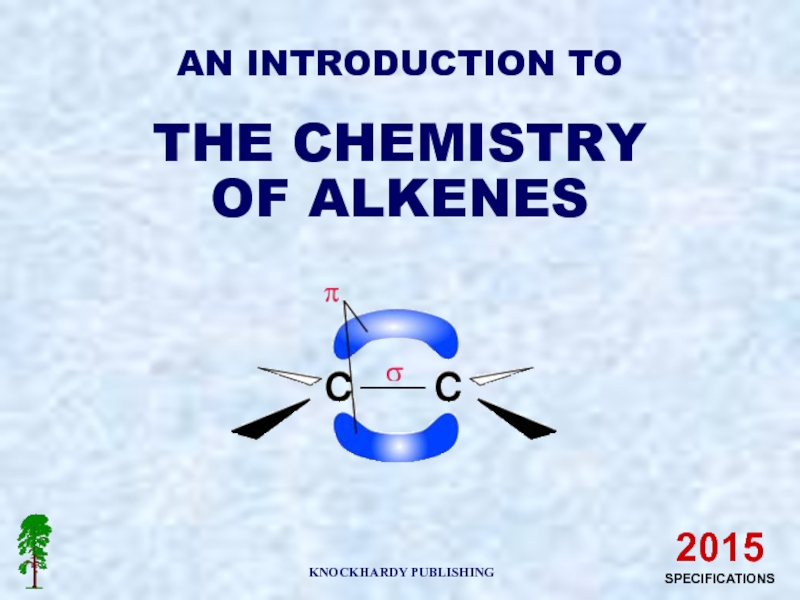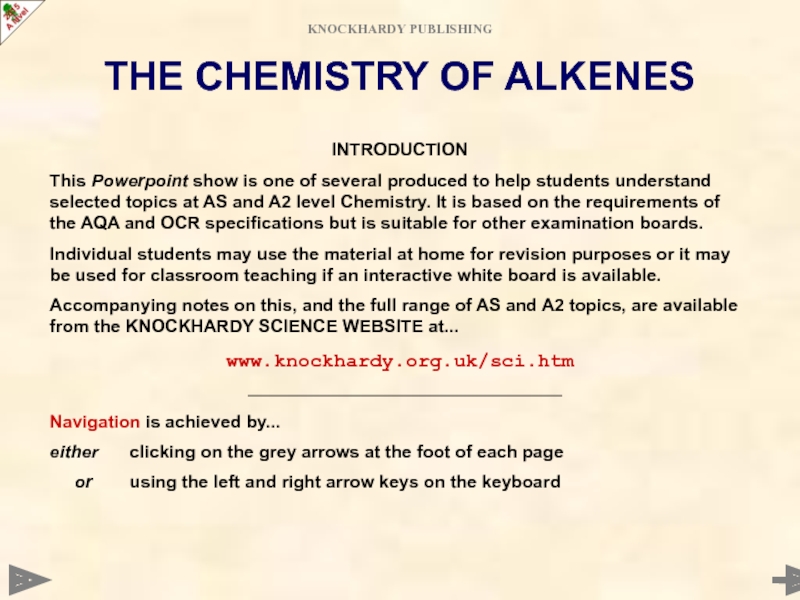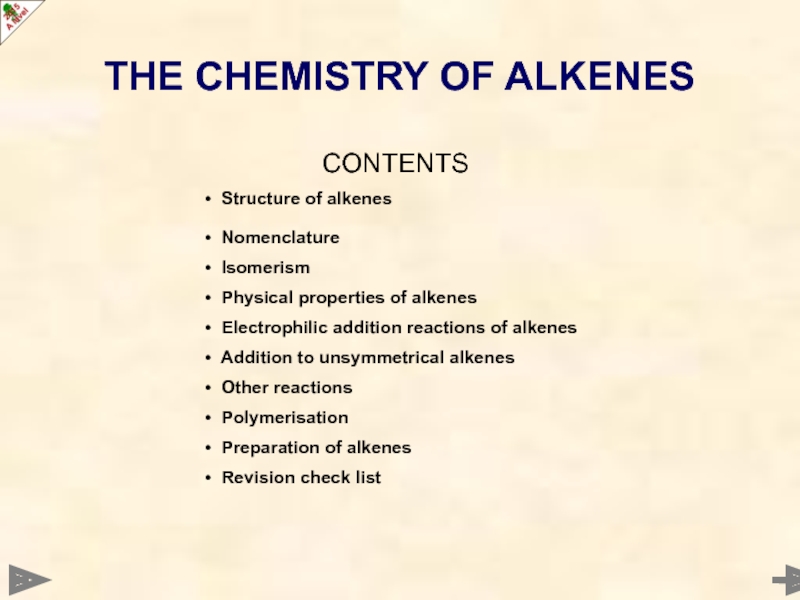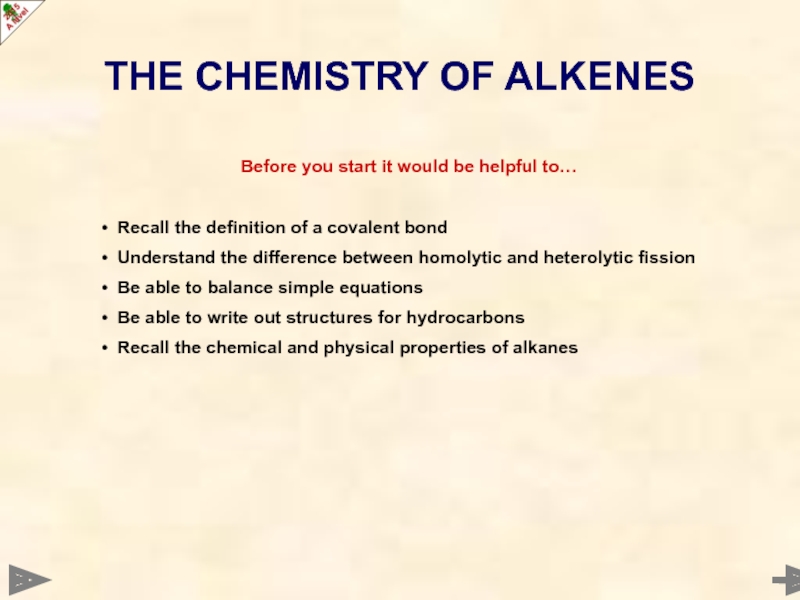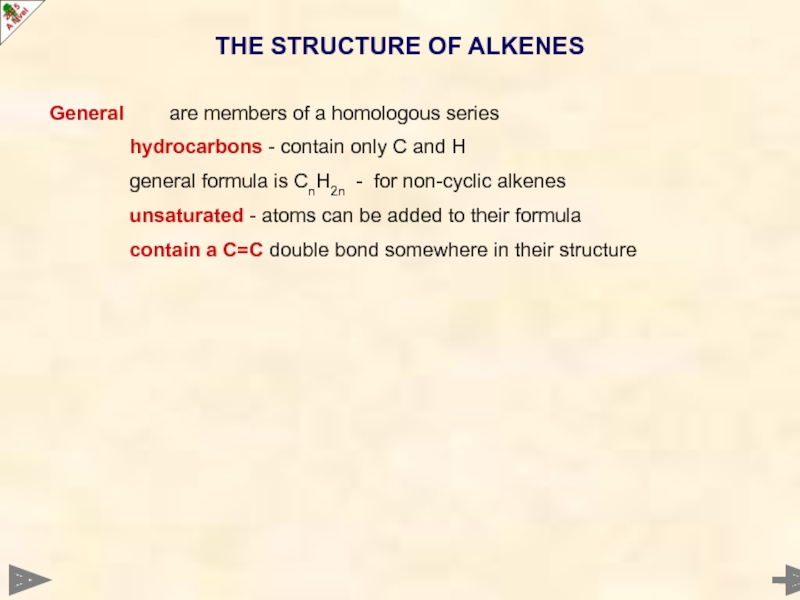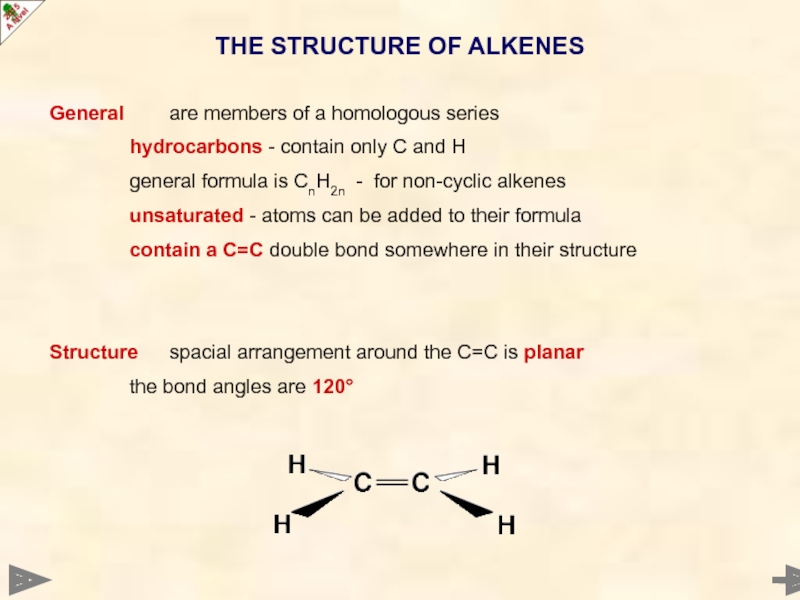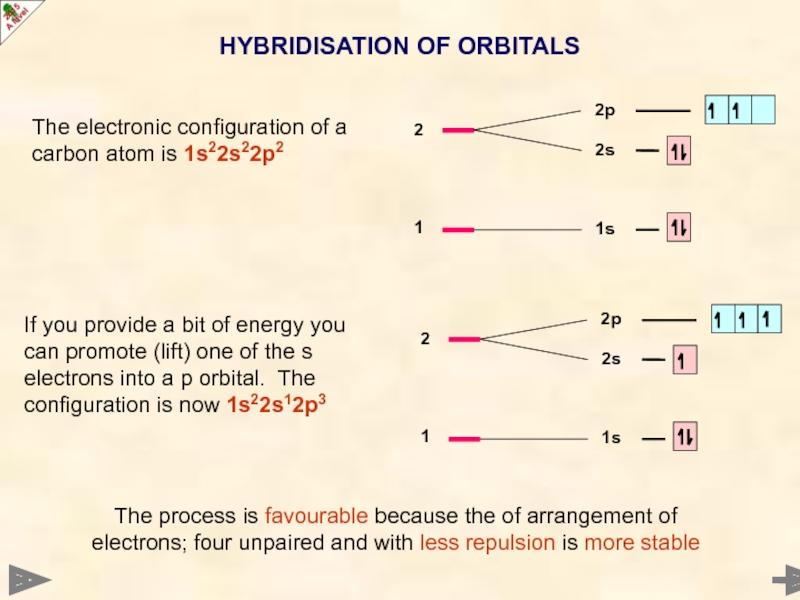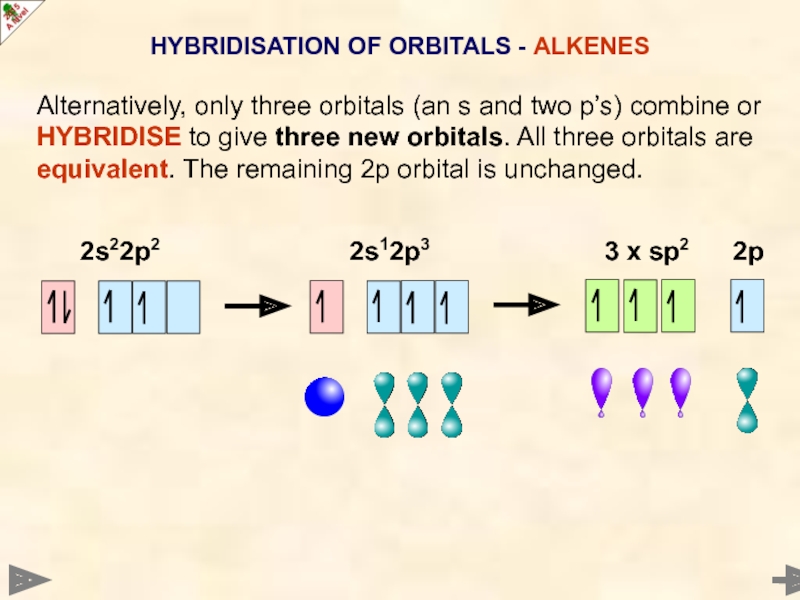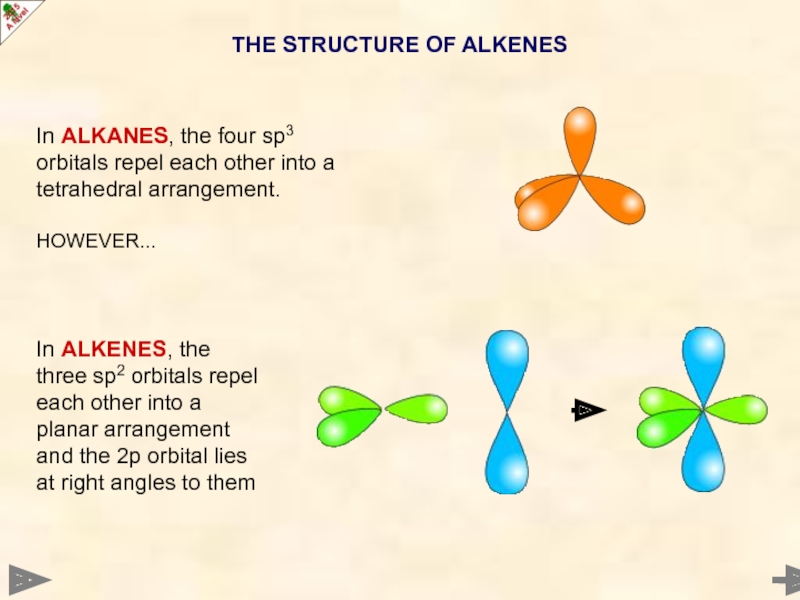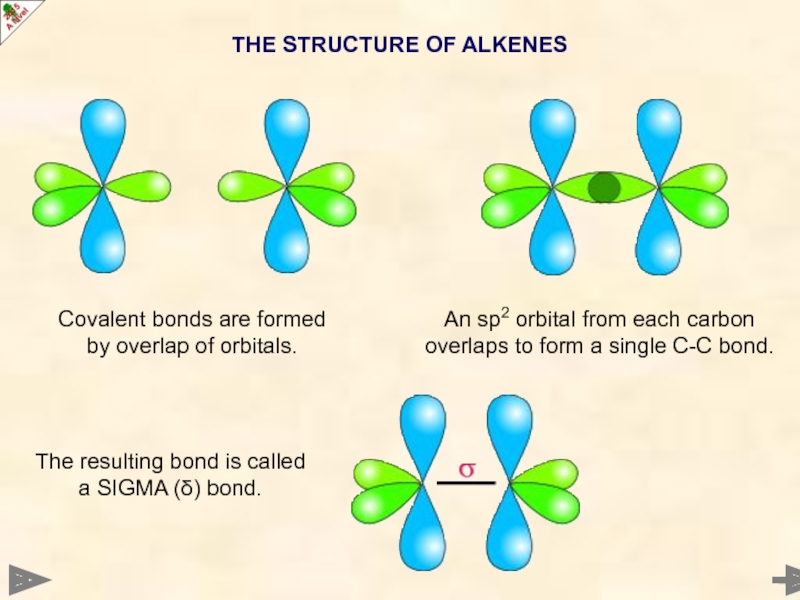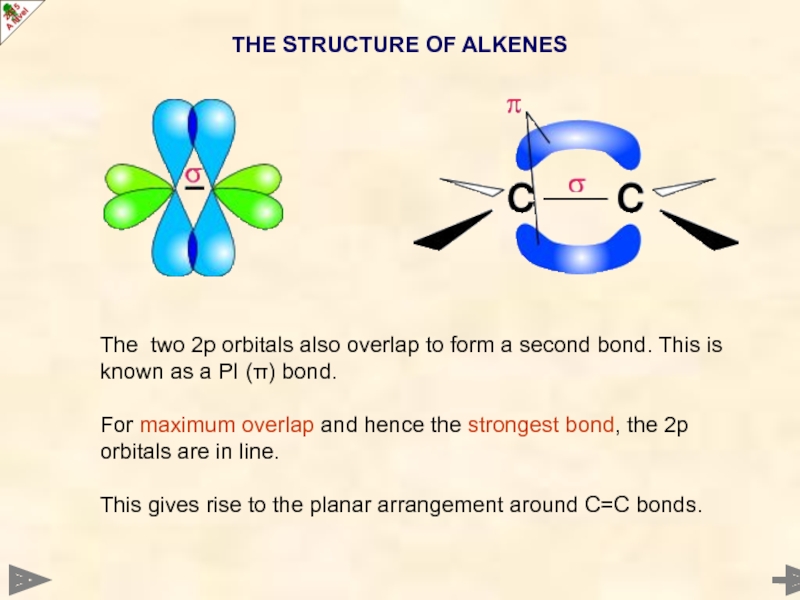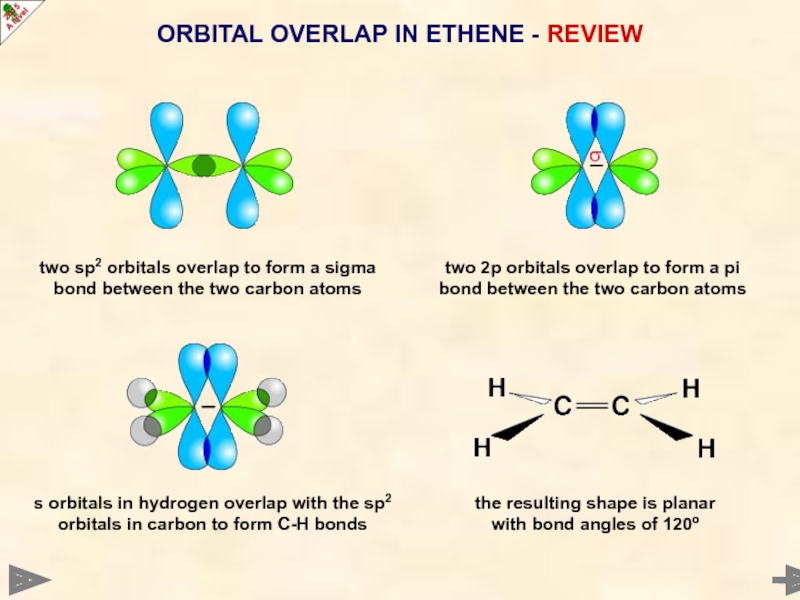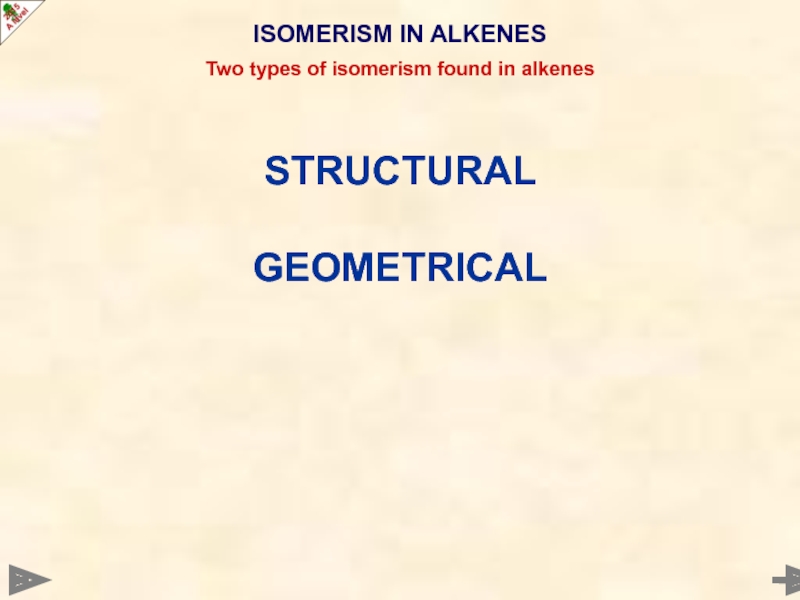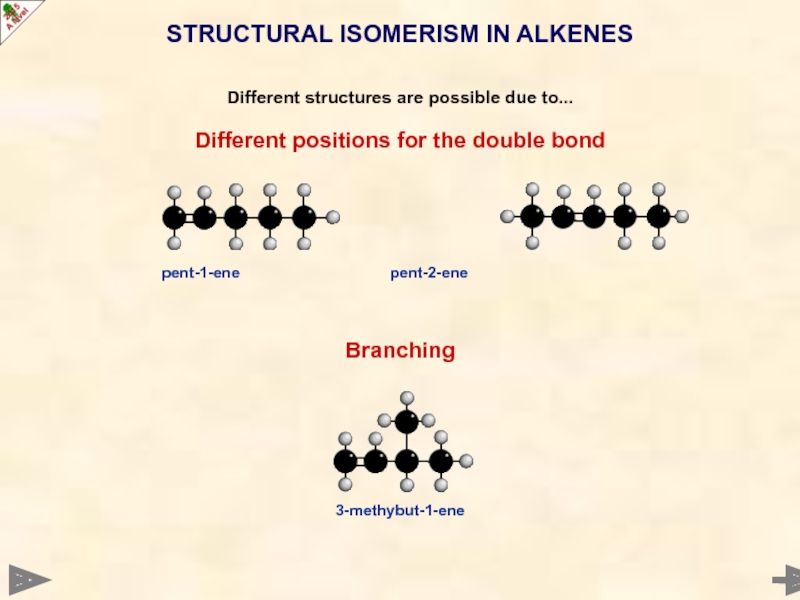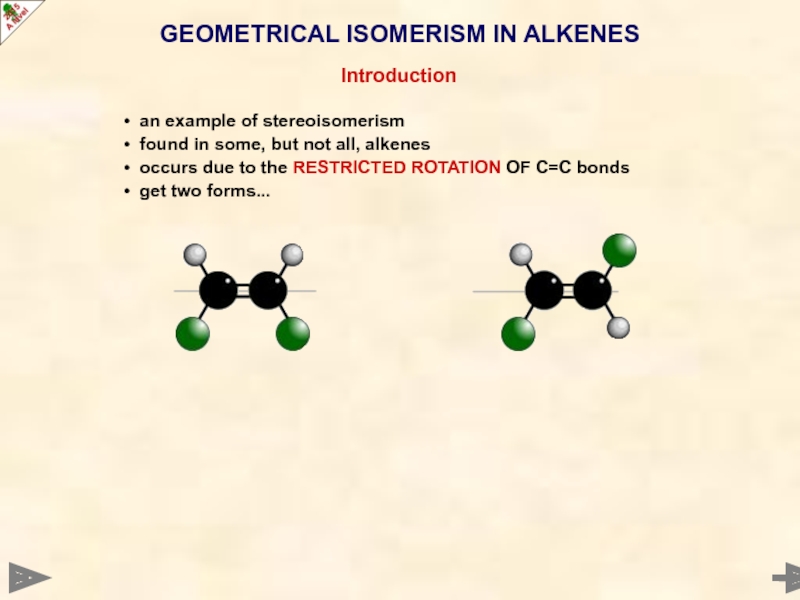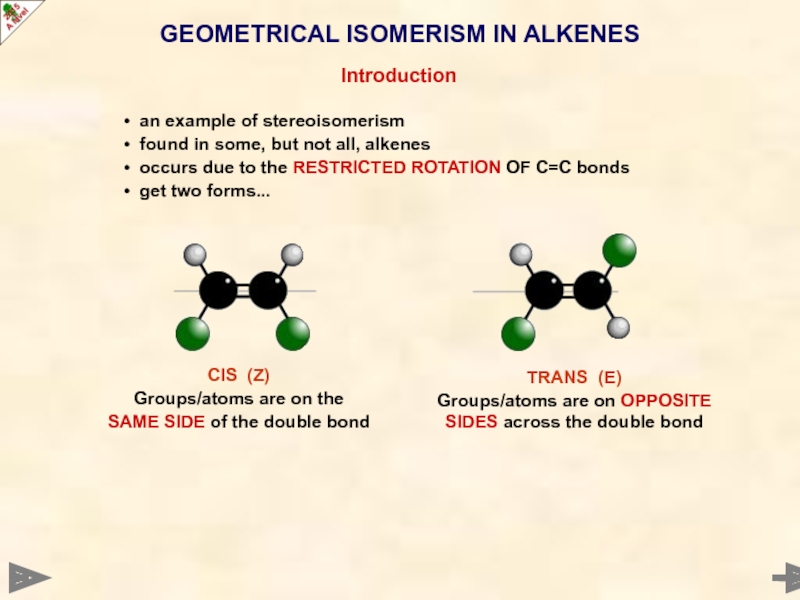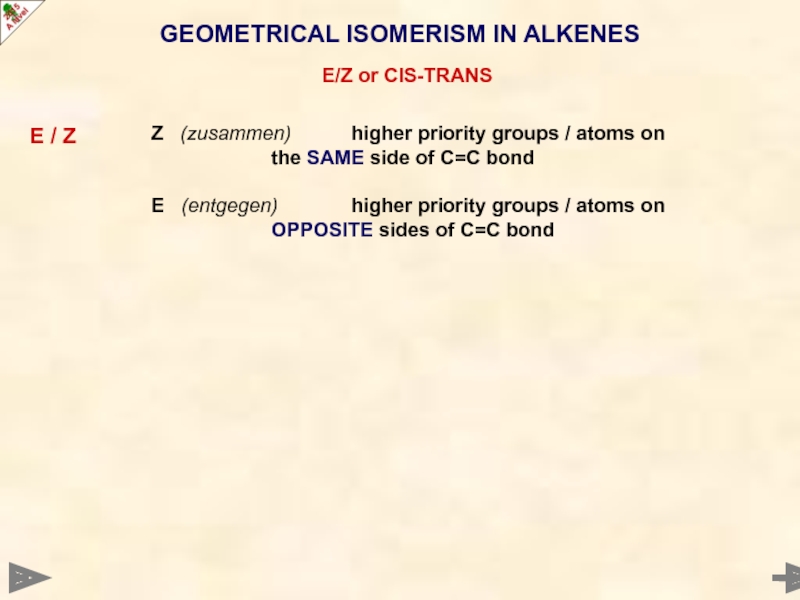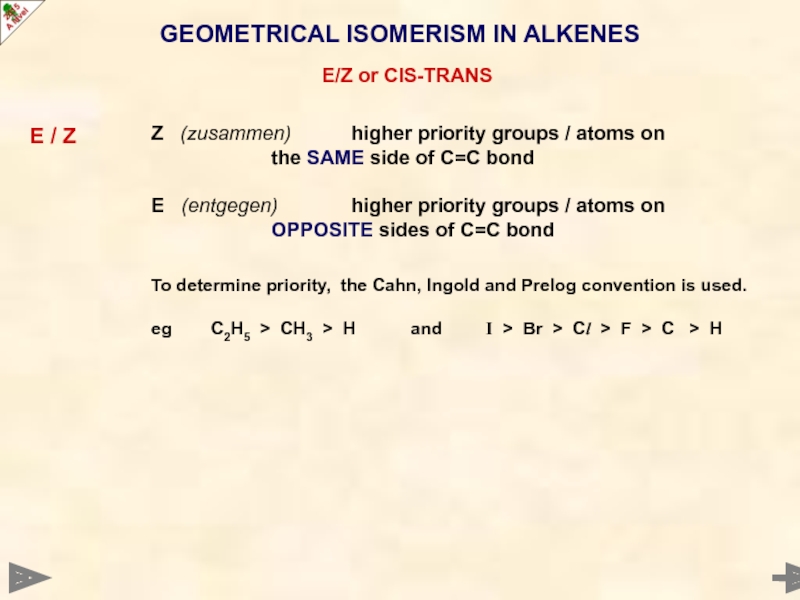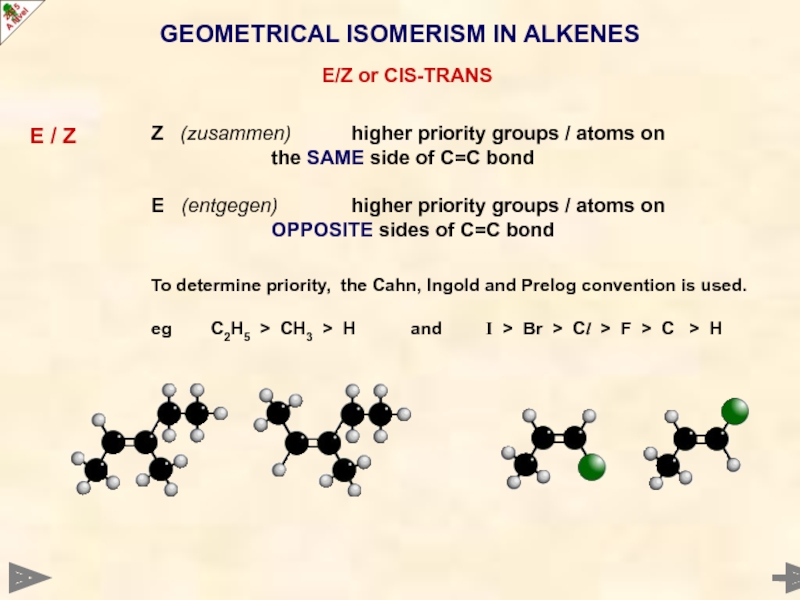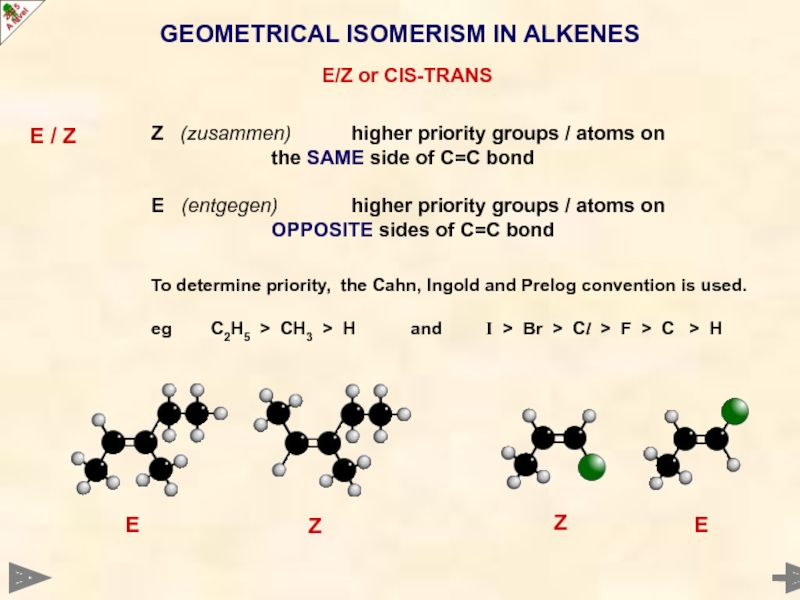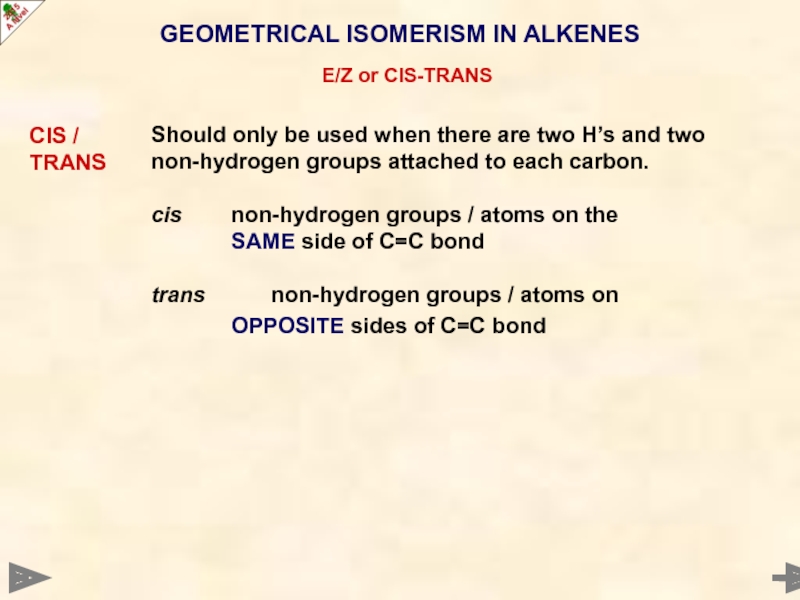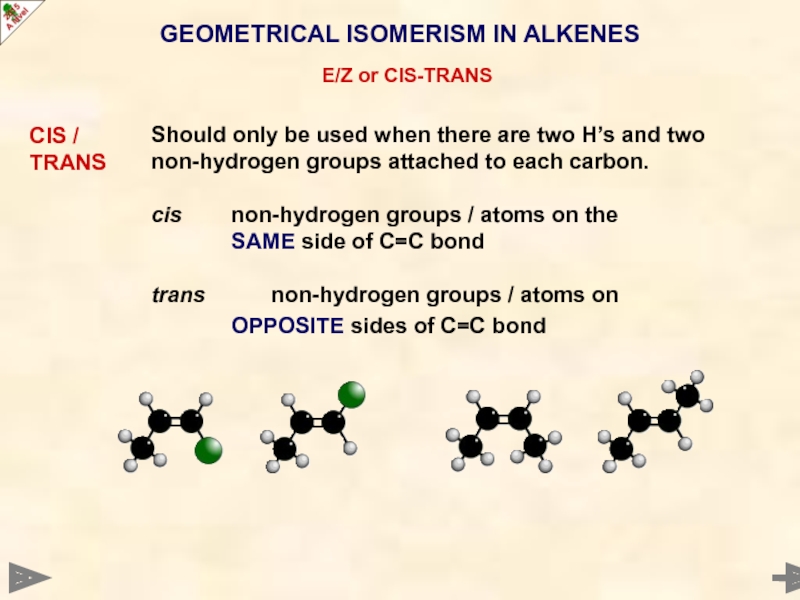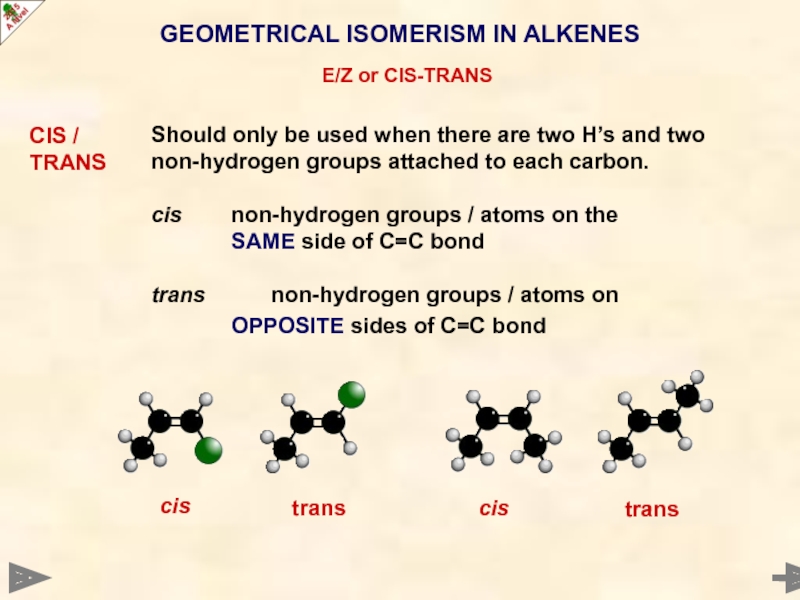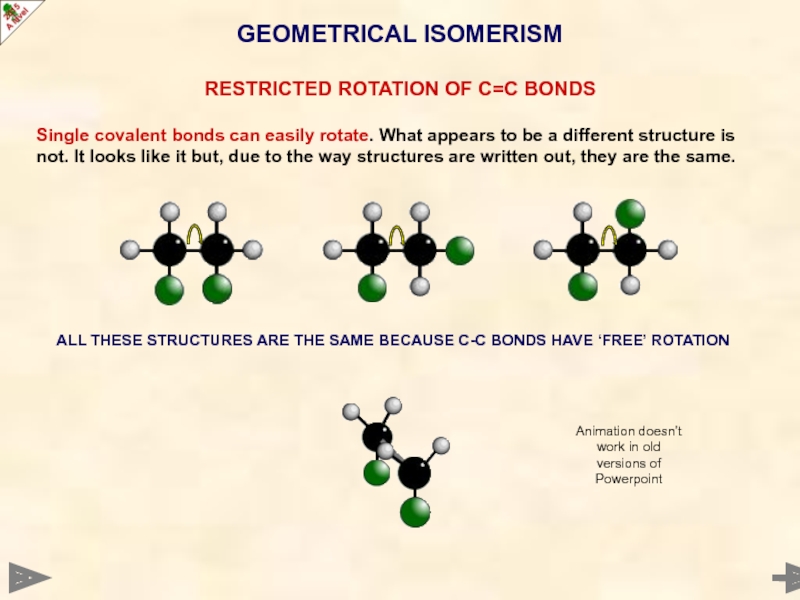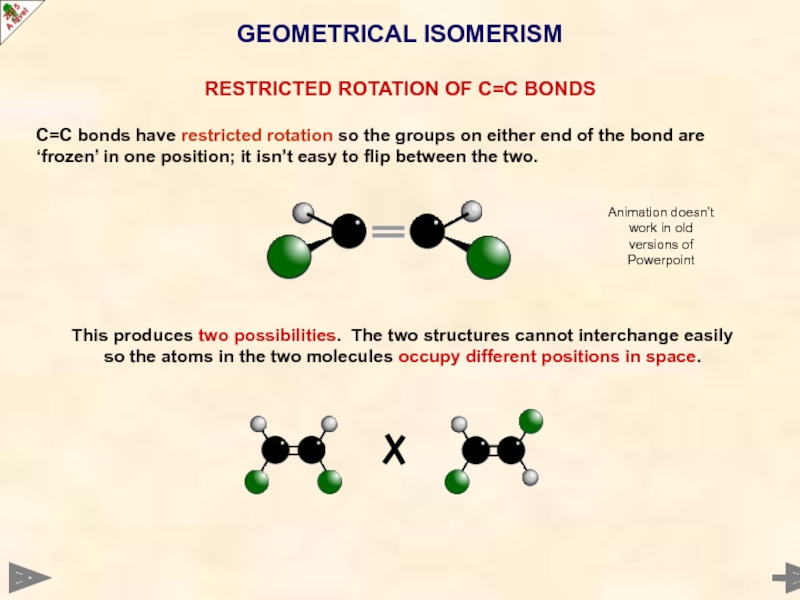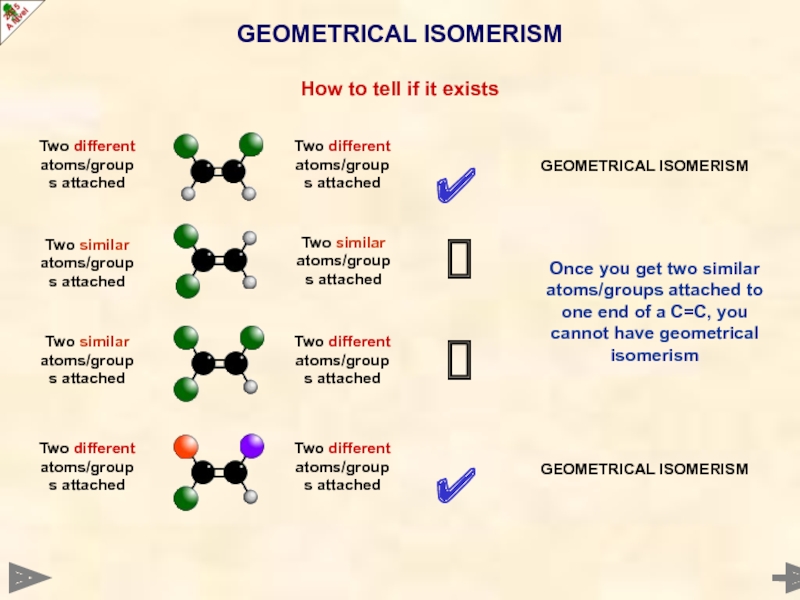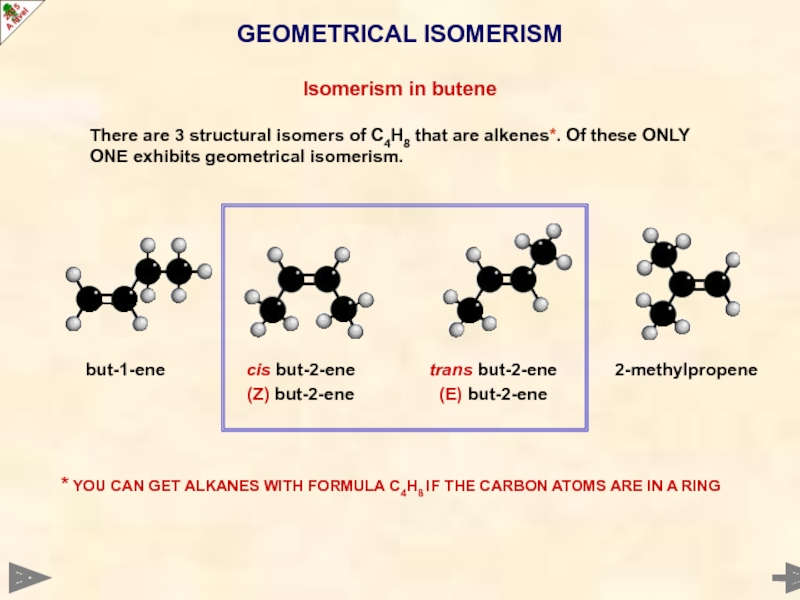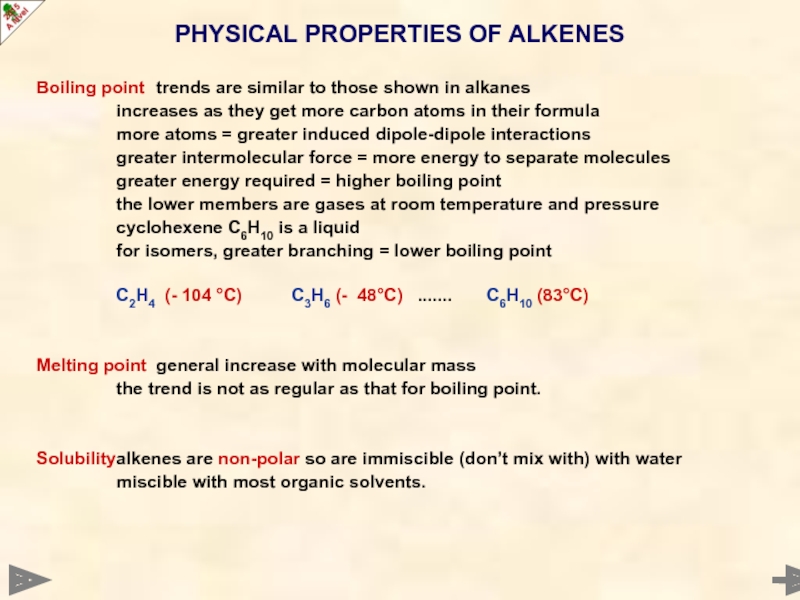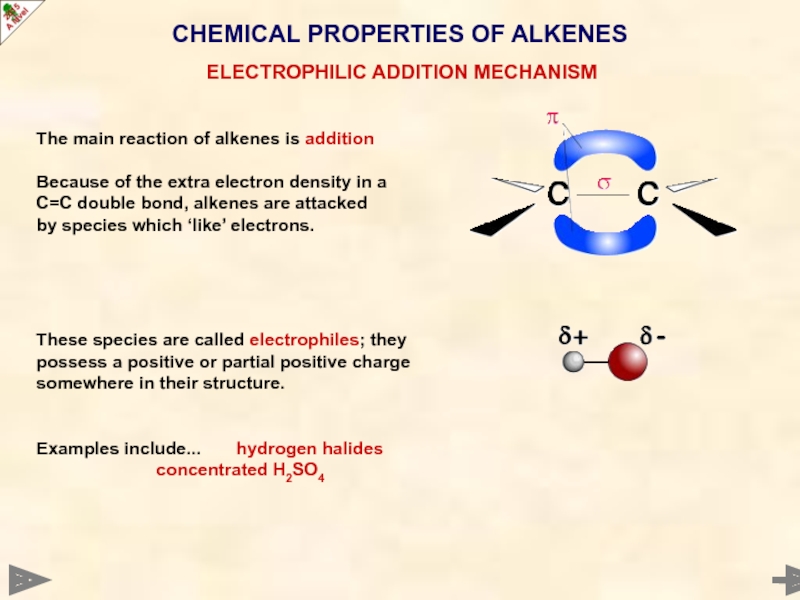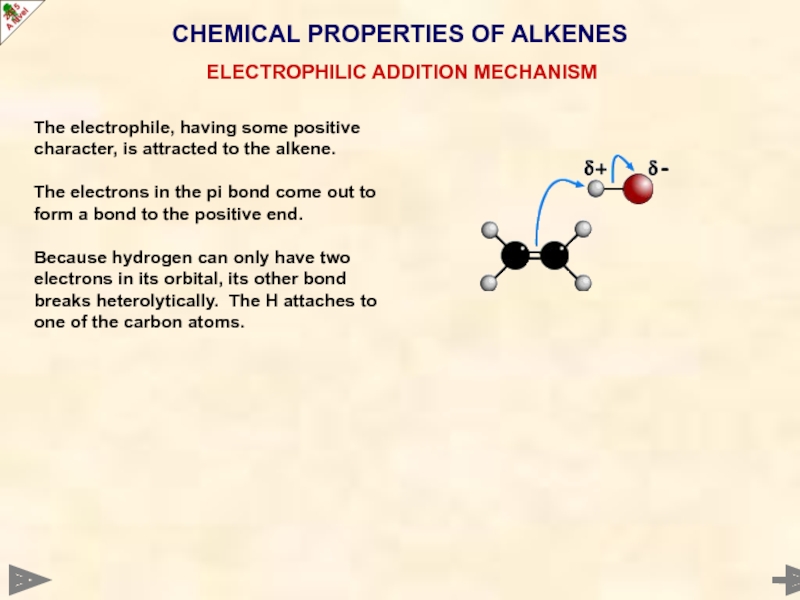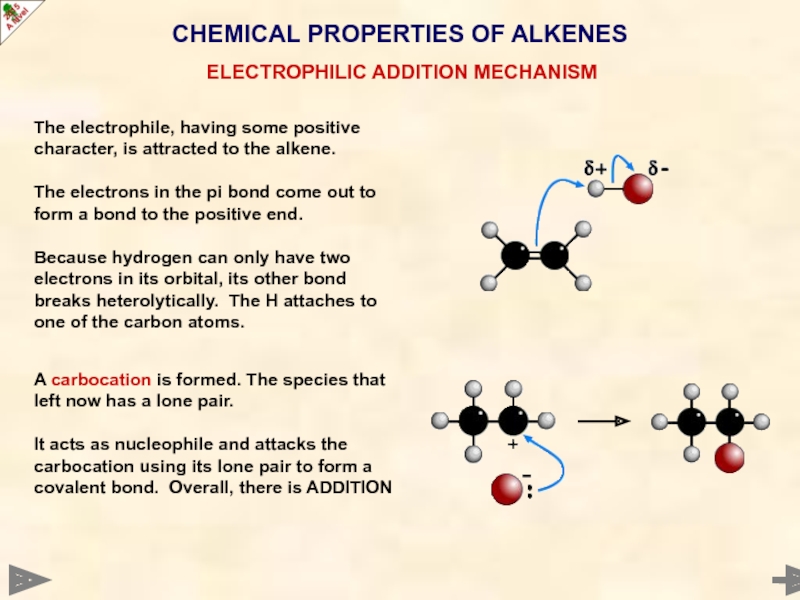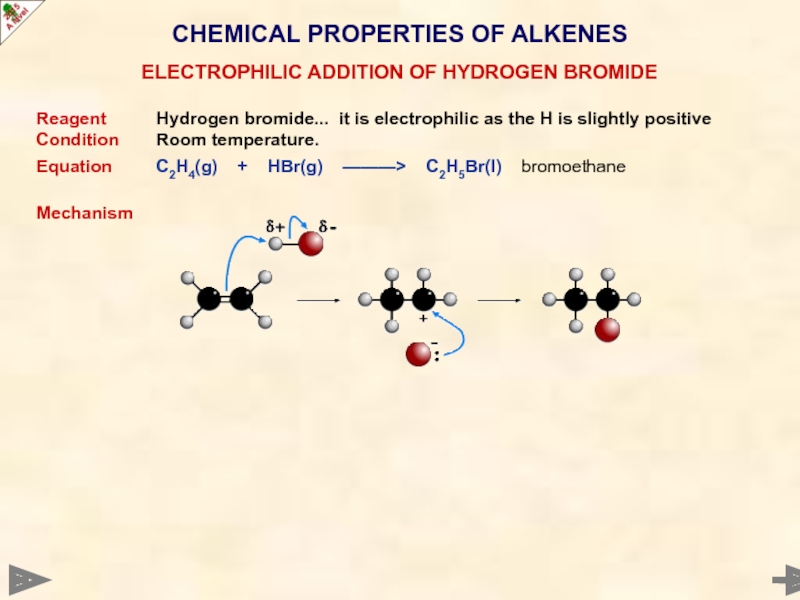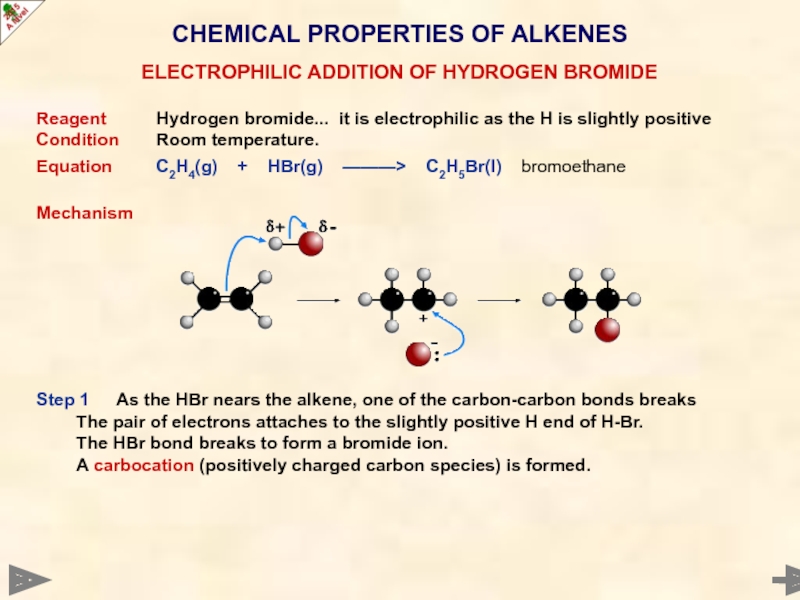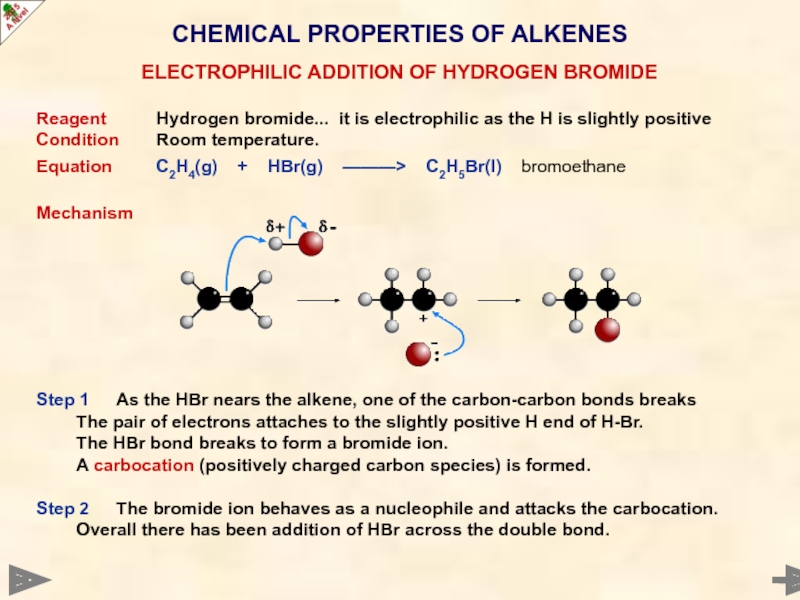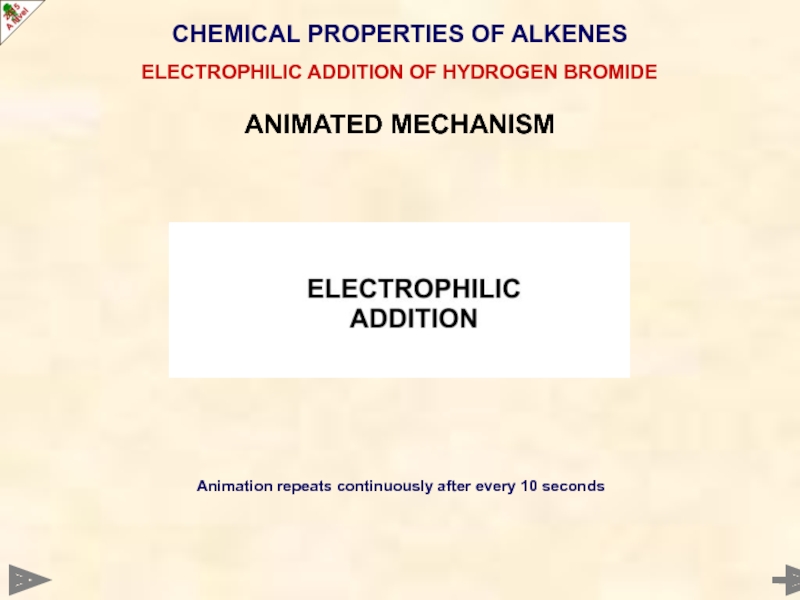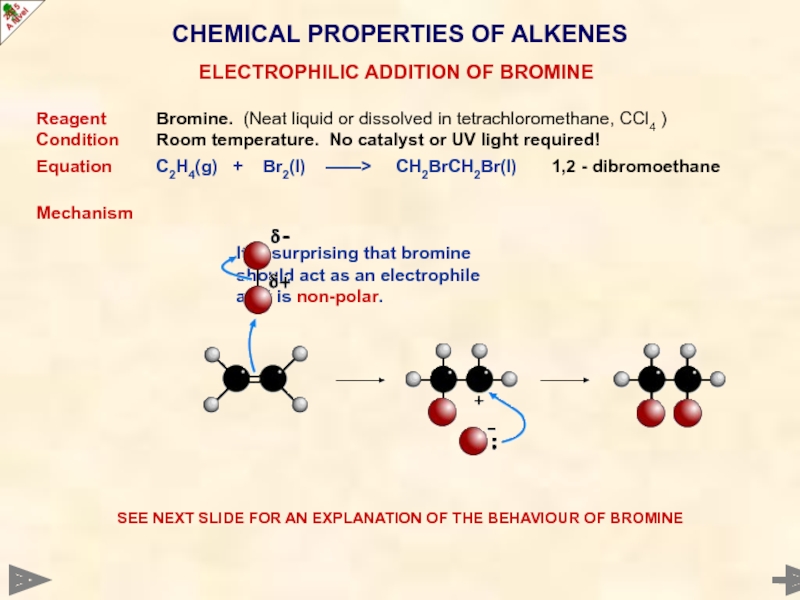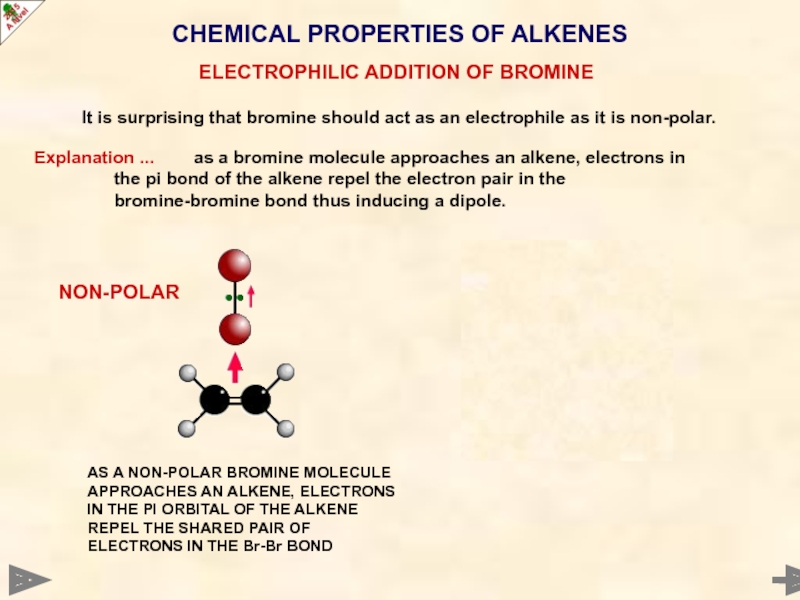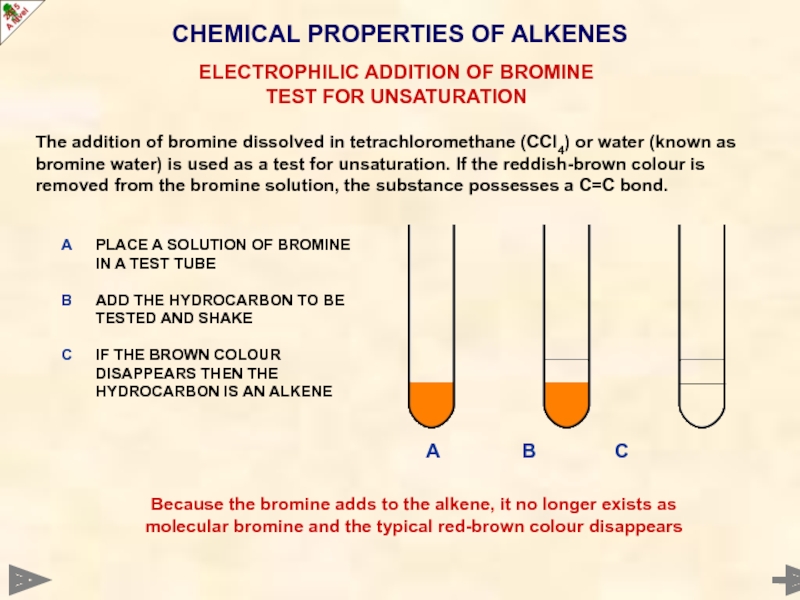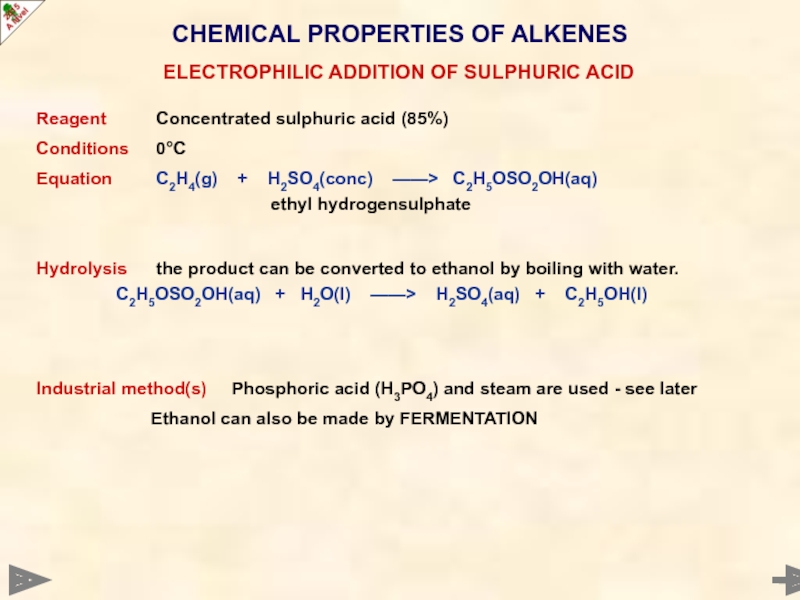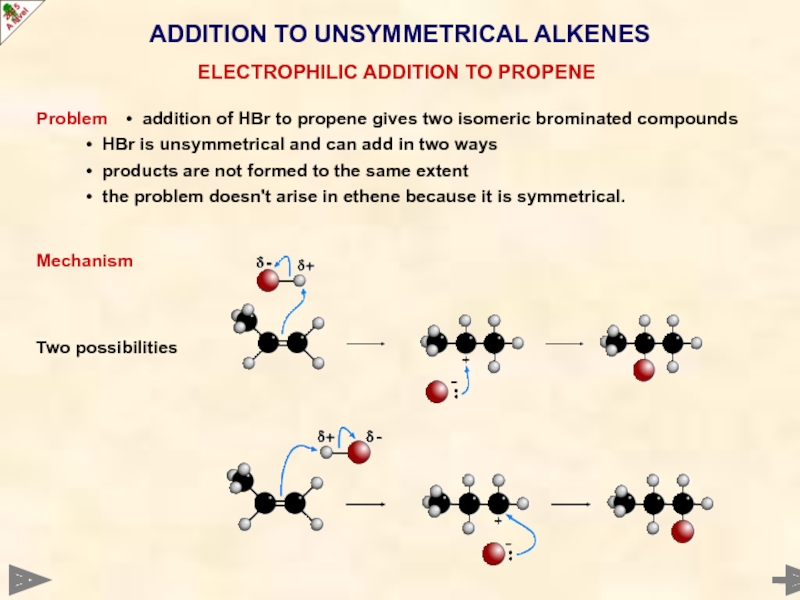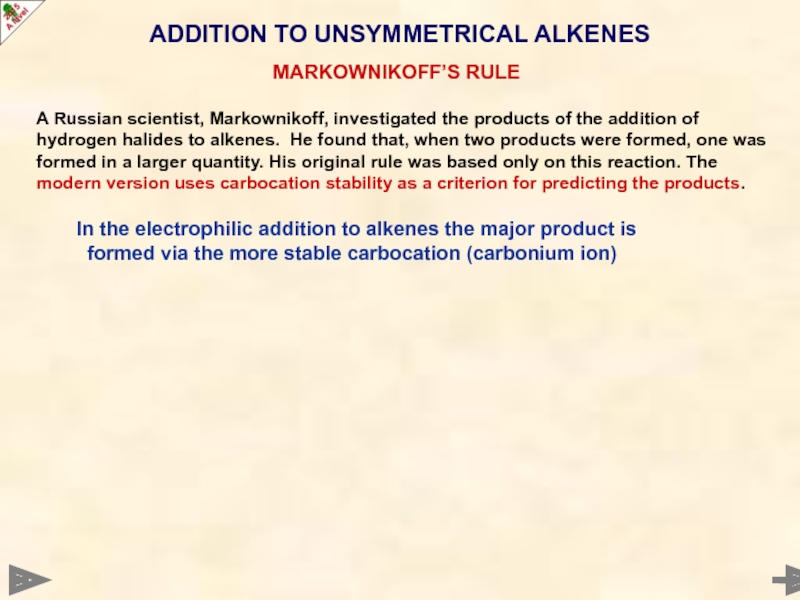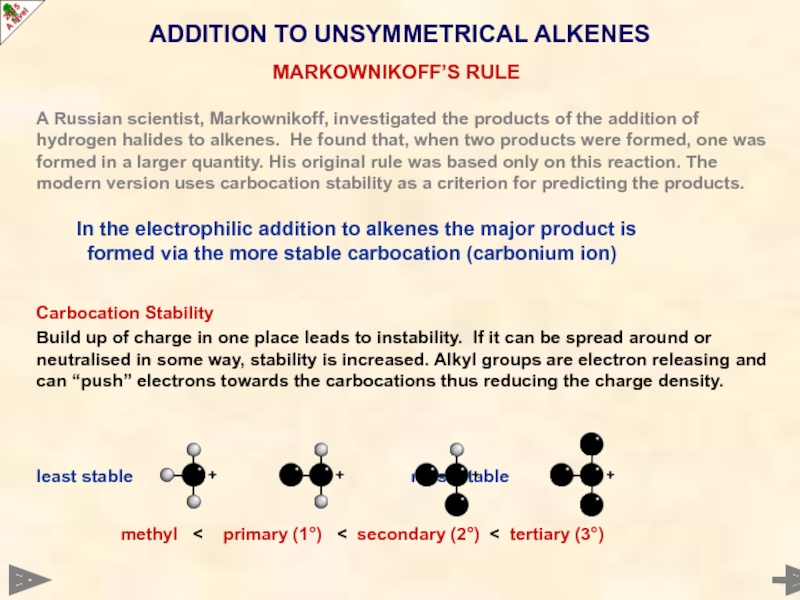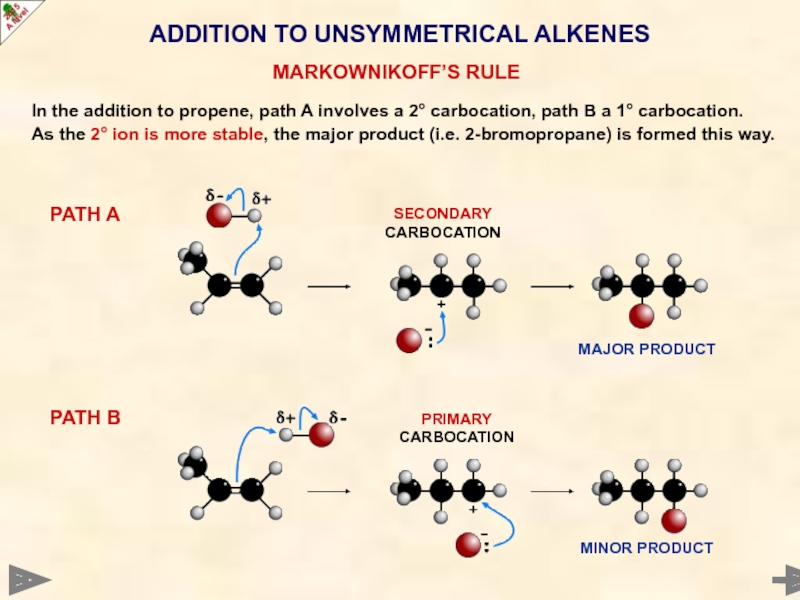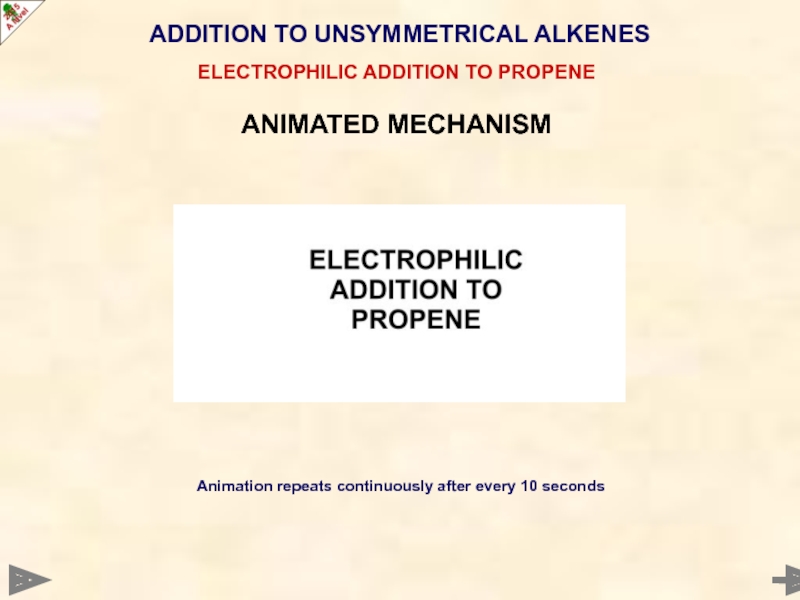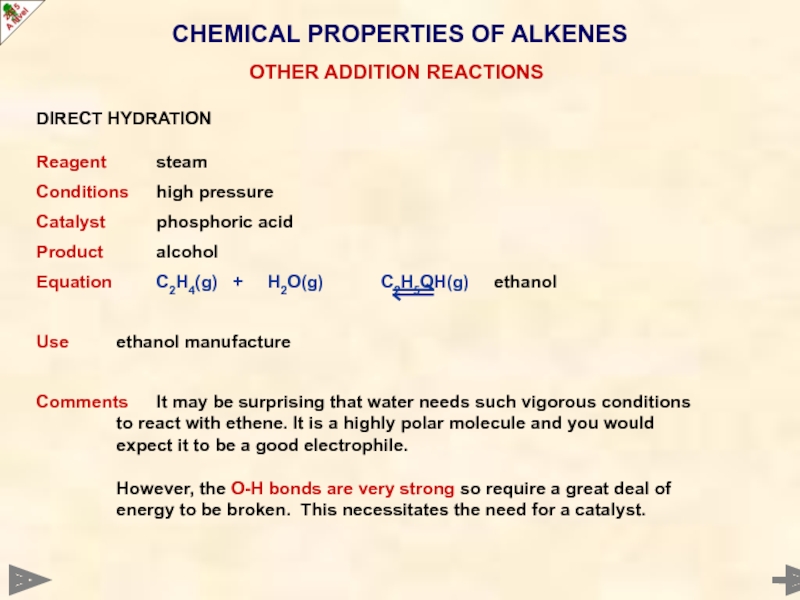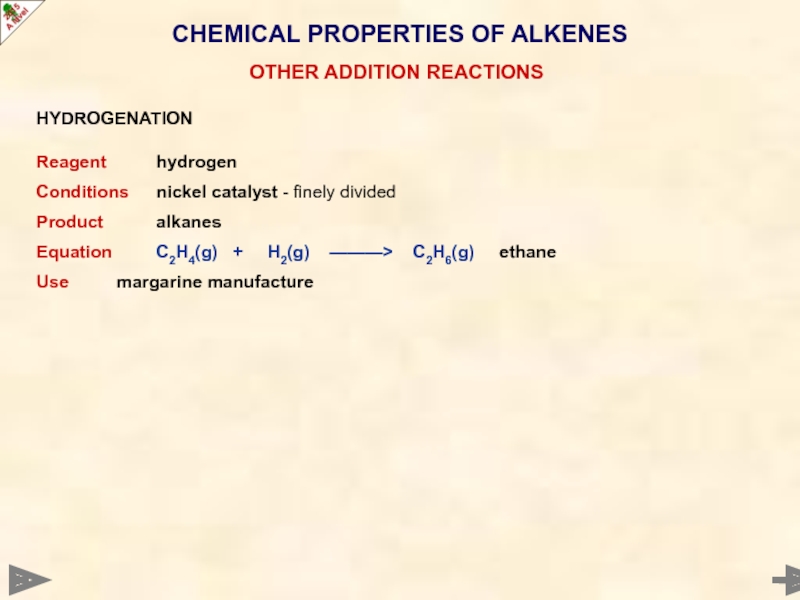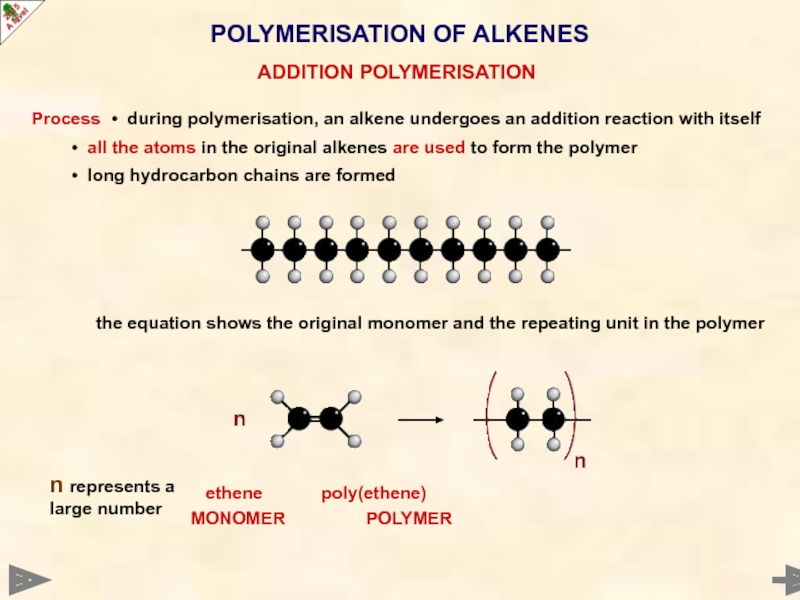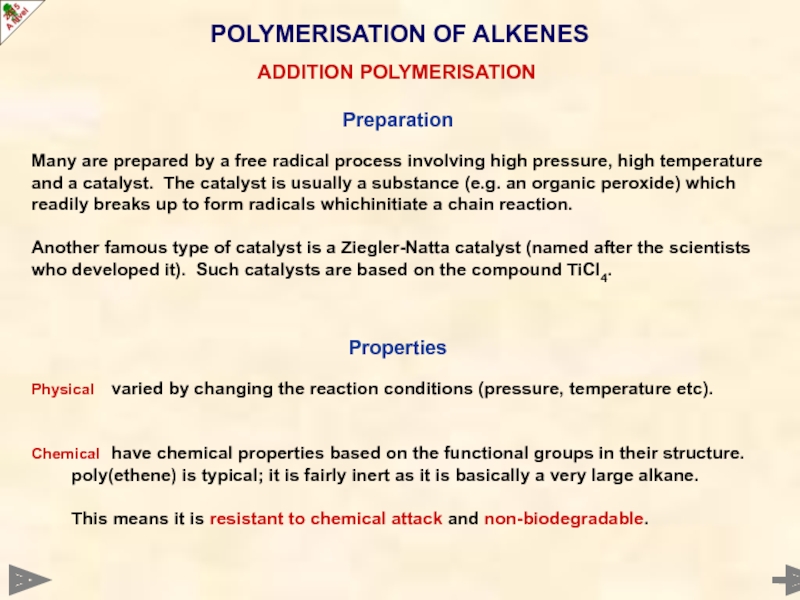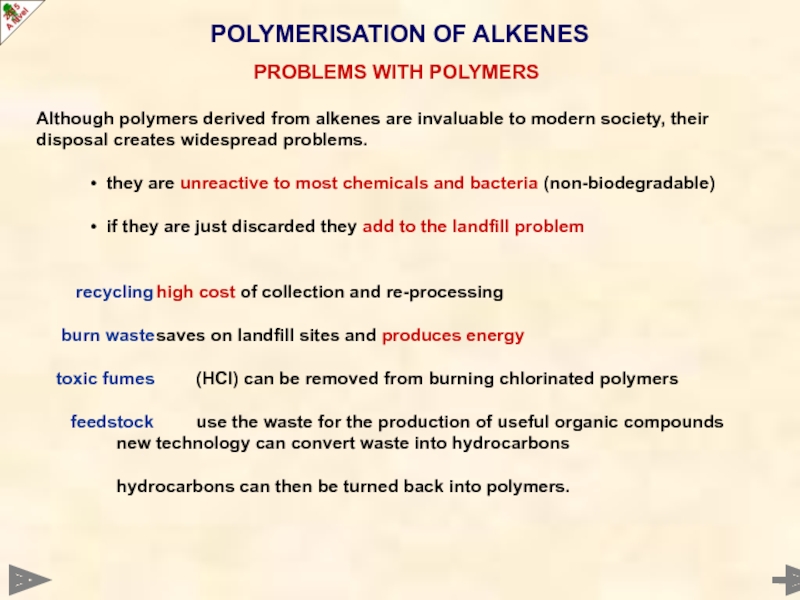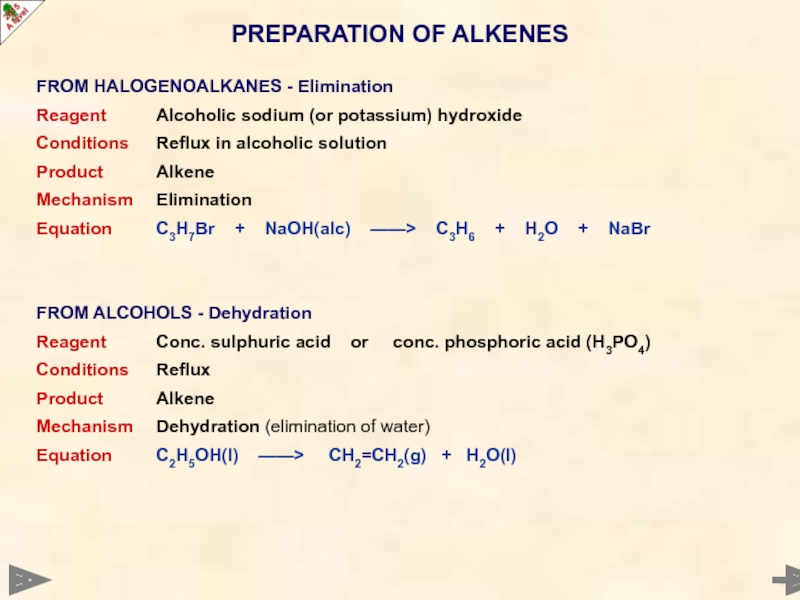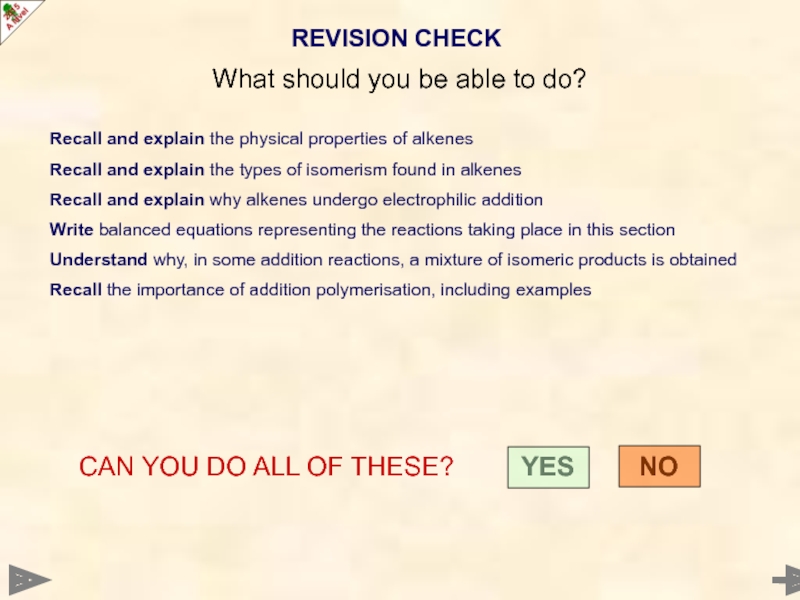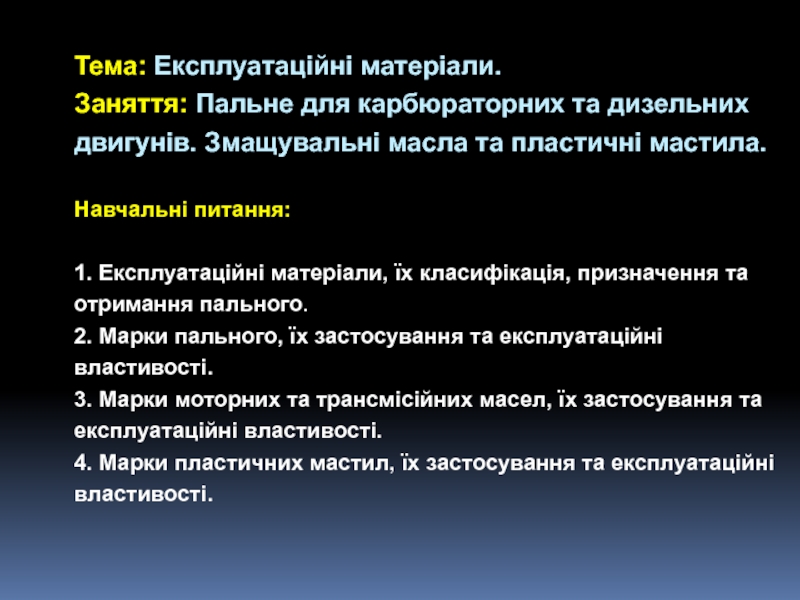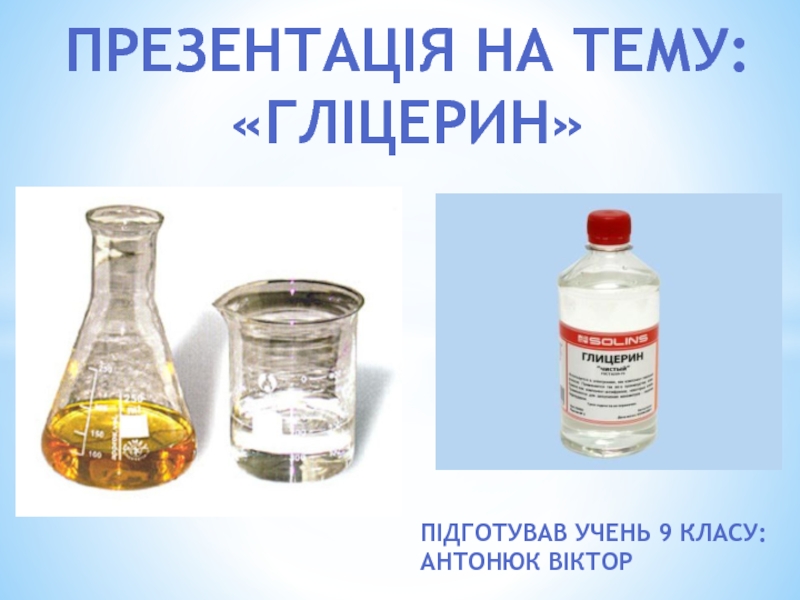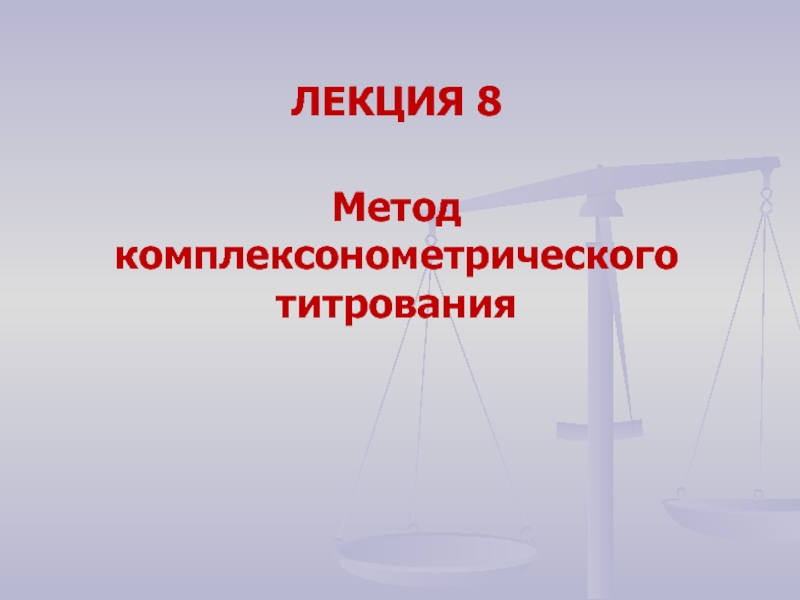- Главная
- Разное
- Дизайн
- Бизнес и предпринимательство
- Аналитика
- Образование
- Развлечения
- Красота и здоровье
- Финансы
- Государство
- Путешествия
- Спорт
- Недвижимость
- Армия
- Графика
- Культурология
- Еда и кулинария
- Лингвистика
- Английский язык
- Астрономия
- Алгебра
- Биология
- География
- Детские презентации
- Информатика
- История
- Литература
- Маркетинг
- Математика
- Медицина
- Менеджмент
- Музыка
- МХК
- Немецкий язык
- ОБЖ
- Обществознание
- Окружающий мир
- Педагогика
- Русский язык
- Технология
- Физика
- Философия
- Химия
- Шаблоны, картинки для презентаций
- Экология
- Экономика
- Юриспруденция
An introduction to the chemistry of alkenes презентация
Содержание
- 1. An introduction to the chemistry of alkenes
- 2. INTRODUCTION This Powerpoint show is
- 4. Before you start it would be helpful
- 5. General are members of a homologous series hydrocarbons
- 6. General are members of a homologous series hydrocarbons
- 7. HYBRIDISATION OF ORBITALS The electronic configuration of a carbon atom is 1s22s22p2
- 8. HYBRIDISATION OF ORBITALS The electronic
- 9. HYBRIDISATION OF ORBITALS -
- 10. HYBRIDISATION OF ORBITALS -
- 11. In ALKANES, the four sp3
- 12. Covalent bonds are formed by
- 13. The two 2p orbitals also
- 14. two sp2 orbitals overlap to form a
- 15. Alkenes are named according to standard IUPAC
- 16. ISOMERISM IN ALKENES Two types
- 17. STRUCTURAL ISOMERISM IN ALKENES Different
- 18. GEOMETRICAL ISOMERISM IN ALKENES Introduction
- 19. GEOMETRICAL ISOMERISM IN ALKENES Introduction
- 20. GEOMETRICAL ISOMERISM IN ALKENES E/Z
- 21. GEOMETRICAL ISOMERISM IN ALKENES E/Z
- 22. GEOMETRICAL ISOMERISM IN ALKENES E/Z
- 23. GEOMETRICAL ISOMERISM IN ALKENES E/Z
- 24. GEOMETRICAL ISOMERISM IN ALKENES E/Z
- 25. GEOMETRICAL ISOMERISM IN ALKENES E/Z
- 26. GEOMETRICAL ISOMERISM IN ALKENES E/Z
- 27. GEOMETRICAL ISOMERISM RESTRICTED ROTATION OF
- 28. GEOMETRICAL ISOMERISM RESTRICTED ROTATION OF
- 29. GEOMETRICAL ISOMERISM How to tell
- 30. GEOMETRICAL ISOMERISM Isomerism in butene
- 31. Boiling point trends are similar to those shown
- 32. CHEMICAL PROPERTIES OF ALKENES ELECTROPHILIC
- 33. CHEMICAL PROPERTIES OF ALKENES ELECTROPHILIC
- 34. CHEMICAL PROPERTIES OF ALKENES ELECTROPHILIC
- 35. CHEMICAL PROPERTIES OF ALKENES Reagent Hydrogen
- 36. CHEMICAL PROPERTIES OF ALKENES Reagent Hydrogen
- 37. CHEMICAL PROPERTIES OF ALKENES Reagent Hydrogen
- 38. CHEMICAL PROPERTIES OF ALKENES ELECTROPHILIC
- 39. CHEMICAL PROPERTIES OF ALKENES Reagent Bromine.
- 40. CHEMICAL PROPERTIES OF ALKENES It
- 41. CHEMICAL PROPERTIES OF ALKENES It
- 42. CHEMICAL PROPERTIES OF ALKENES The
- 43. CHEMICAL PROPERTIES OF ALKENES Reagent Concentrated
- 44. ADDITION TO UNSYMMETRICAL ALKENES Problem
- 45. A Russian scientist, Markownikoff, investigated
- 46. A Russian scientist, Markownikoff, investigated
- 47. In the addition to propene,
- 48. ADDITION TO UNSYMMETRICAL ALKENES ELECTROPHILIC
- 49. CHEMICAL PROPERTIES OF ALKENES DIRECT
- 50. CHEMICAL PROPERTIES OF ALKENES HYDROGENATION
- 51. POLYMERISATION OF ALKENES Process • during
- 52. POLYMERISATION OF ALKENES ETHENE EXAMPLES
- 53. Preparation Many are prepared
- 54. POLYMERISATION OF ALKENES Although polymers
- 55. PREPARATION OF ALKENES FROM HALOGENOALKANES
- 56. REVISION CHECK What should you be able
- 57. You need to go over the relevant
- 58. WELL DONE! Try some past paper questions
- 59. © 2015 JONATHAN HOPTON & KNOCKHARDY
Слайд 2
INTRODUCTION
This Powerpoint show is one of several produced to help students
Individual students may use the material at home for revision purposes or it may be used for classroom teaching if an interactive white board is available.
Accompanying notes on this, and the full range of AS and A2 topics, are available from the KNOCKHARDY SCIENCE WEBSITE at...
www.knockhardy.org.uk/sci.htm
Navigation is achieved by...
either clicking on the grey arrows at the foot of each page
or using the left and right arrow keys on the keyboard
KNOCKHARDY PUBLISHING
THE CHEMISTRY OF ALKENES
Слайд 3 CONTENTS
Structure of
Nomenclature
Isomerism
Physical properties of alkenes
Electrophilic addition reactions of alkenes
Addition to unsymmetrical alkenes
Other reactions
Polymerisation
Preparation of alkenes
Revision check list
THE CHEMISTRY OF ALKENES
Слайд 4Before you start it would be helpful to…
Recall the definition
Understand the difference between homolytic and heterolytic fission
Be able to balance simple equations
Be able to write out structures for hydrocarbons
Recall the chemical and physical properties of alkanes
THE CHEMISTRY OF ALKENES
Слайд 5General are members of a homologous series
hydrocarbons - contain only C and
general formula is CnH2n - for non-cyclic alkenes
unsaturated - atoms can be added to their formula
contain a C=C double bond somewhere in their structure
THE STRUCTURE OF ALKENES
Слайд 6General are members of a homologous series
hydrocarbons - contain only C and
general formula is CnH2n - for non-cyclic alkenes
unsaturated - atoms can be added to their formula
contain a C=C double bond somewhere in their structure
Structure spacial arrangement around the C=C is planar
the bond angles are 120°
THE STRUCTURE OF ALKENES
Слайд 8
HYBRIDISATION OF ORBITALS
The electronic configuration of a carbon atom is 1s22s22p2
If
The process is favourable because the of arrangement of electrons; four unpaired and with less repulsion is more stable
Слайд 9
HYBRIDISATION OF ORBITALS - ALKANES
The four orbitals (an s and three
2s22p2
2s12p3
4 x sp3
Слайд 10
HYBRIDISATION OF ORBITALS - ALKENES
Alternatively, only three orbitals (an s and
2s22p2
2s12p3
3 x sp2
2p
Слайд 11
In ALKANES, the four sp3 orbitals repel each other into a
HOWEVER...
In ALKENES, the three sp2 orbitals repel each other into a planar arrangement and the 2p orbital lies at right angles to them
THE STRUCTURE OF ALKENES
Слайд 12
Covalent bonds are formed by overlap of orbitals.
An sp2 orbital from
The resulting bond is called a SIGMA (δ) bond.
THE STRUCTURE OF ALKENES
Слайд 13
The two 2p orbitals also overlap to form a second bond.
For maximum overlap and hence the strongest bond, the 2p orbitals are in line.
This gives rise to the planar arrangement around C=C bonds.
THE STRUCTURE OF ALKENES
Слайд 14two sp2 orbitals overlap to form a sigma bond between the
ORBITAL OVERLAP IN ETHENE - REVIEW
two 2p orbitals overlap to form a pi bond between the two carbon atoms
s orbitals in hydrogen overlap with the sp2 orbitals in carbon to form C-H bonds
the resulting shape is planar with bond angles of 120º
Слайд 15Alkenes are named according to standard IUPAC rules
• select the longest
• place the ending ENE on the basic name
• number the chain starting from the end nearer the double bond
• use a number to indicate the lower number carbon of the C=C
• as in alkanes, prefix with substituents
• side chain positions are based on the number allocated to the first C of the C=C
• if geometrical isomerism exists, prefix with cis or trans
e.g. CH3 - CH = CH - CH2 - CH(CH3) - CH3 is called 5-methylhex-2-ene
NAMING ALKENES
Слайд 17
STRUCTURAL ISOMERISM IN ALKENES
Different structures are possible due to...
Different positions for
pent-1-ene pent-2-ene
Branching
3-methybut-1-ene
Слайд 18GEOMETRICAL ISOMERISM IN ALKENES
Introduction
an example of stereoisomerism
found in some,
occurs due to the RESTRICTED ROTATION OF C=C bonds
get two forms...
Слайд 19GEOMETRICAL ISOMERISM IN ALKENES
Introduction
an example of stereoisomerism
found in some,
occurs due to the RESTRICTED ROTATION OF C=C bonds
get two forms...
CIS (Z)
Groups/atoms are on the
SAME SIDE of the double bond
TRANS (E)
Groups/atoms are on OPPOSITE SIDES across the double bond
Слайд 20GEOMETRICAL ISOMERISM IN ALKENES
E/Z or CIS-TRANS
E / Z
Z (zusammen) higher priority
the SAME side of C=C bond
E (entgegen) higher priority groups / atoms on
OPPOSITE sides of C=C bond
Слайд 21GEOMETRICAL ISOMERISM IN ALKENES
E/Z or CIS-TRANS
E / Z
Z (zusammen) higher priority
the SAME side of C=C bond
E (entgegen) higher priority groups / atoms on
OPPOSITE sides of C=C bond
To determine priority, the Cahn, Ingold and Prelog convention is used.
eg C2H5 > CH3 > H and I > Br > Cl > F > C > H
Слайд 22GEOMETRICAL ISOMERISM IN ALKENES
E/Z or CIS-TRANS
E / Z
Z (zusammen) higher priority
the SAME side of C=C bond
E (entgegen) higher priority groups / atoms on
OPPOSITE sides of C=C bond
To determine priority, the Cahn, Ingold and Prelog convention is used.
eg C2H5 > CH3 > H and I > Br > Cl > F > C > H
Слайд 23GEOMETRICAL ISOMERISM IN ALKENES
E/Z or CIS-TRANS
E / Z
Z (zusammen) higher priority
the SAME side of C=C bond
E (entgegen) higher priority groups / atoms on
OPPOSITE sides of C=C bond
To determine priority, the Cahn, Ingold and Prelog convention is used.
eg C2H5 > CH3 > H and I > Br > Cl > F > C > H
E
Z
Z
E
Слайд 24GEOMETRICAL ISOMERISM IN ALKENES
E/Z or CIS-TRANS
CIS /
TRANS
Should only be used
cis non-hydrogen groups / atoms on the
SAME side of C=C bond
trans non-hydrogen groups / atoms on
OPPOSITE sides of C=C bond
Слайд 25GEOMETRICAL ISOMERISM IN ALKENES
E/Z or CIS-TRANS
CIS /
TRANS
Should only be used
cis non-hydrogen groups / atoms on the
SAME side of C=C bond
trans non-hydrogen groups / atoms on
OPPOSITE sides of C=C bond
Слайд 26GEOMETRICAL ISOMERISM IN ALKENES
E/Z or CIS-TRANS
CIS /
TRANS
Should only be used
cis non-hydrogen groups / atoms on the
SAME side of C=C bond
trans non-hydrogen groups / atoms on
OPPOSITE sides of C=C bond
cis
trans
cis
trans
Слайд 27GEOMETRICAL ISOMERISM
RESTRICTED ROTATION OF C=C BONDS
Single covalent bonds can easily rotate.
ALL THESE STRUCTURES ARE THE SAME BECAUSE C-C BONDS HAVE ‘FREE’ ROTATION
Animation doesn’t work in old versions of Powerpoint
Слайд 28GEOMETRICAL ISOMERISM
RESTRICTED ROTATION OF C=C BONDS
C=C bonds have restricted rotation so
This produces two possibilities. The two structures cannot interchange easily so the atoms in the two molecules occupy different positions in space.
Animation doesn’t work in old versions of Powerpoint
Слайд 29GEOMETRICAL ISOMERISM
How to tell if it exists
✔
?
?
✔
Two
Two different atoms/groups attached
Two similar atoms/groups attached
Two similar atoms/groups attached
Two similar atoms/groups attached
Two different atoms/groups attached
Two different atoms/groups attached
Two different atoms/groups attached
GEOMETRICAL ISOMERISM
GEOMETRICAL ISOMERISM
Once you get two similar atoms/groups attached to one end of a C=C, you cannot have geometrical isomerism
Слайд 30GEOMETRICAL ISOMERISM
Isomerism in butene
There are 3 structural isomers of C4H8 that
but-1-ene
2-methylpropene
trans but-2-ene
(E) but-2-ene
cis but-2-ene
(Z) but-2-ene
* YOU CAN GET ALKANES WITH FORMULA C4H8 IF THE CARBON ATOMS ARE IN A RING
Слайд 31Boiling point trends are similar to those shown in alkanes
increases as they
more atoms = greater induced dipole-dipole interactions
greater intermolecular force = more energy to separate molecules
greater energy required = higher boiling point
the lower members are gases at room temperature and pressure
cyclohexene C6H10 is a liquid
for isomers, greater branching = lower boiling point
C2H4 (- 104 °C) C3H6 (- 48°C) ....... C6H10 (83°C)
Melting point general increase with molecular mass
the trend is not as regular as that for boiling point.
Solubility alkenes are non-polar so are immiscible (don’t mix with) with water
miscible with most organic solvents.
PHYSICAL PROPERTIES OF ALKENES
Слайд 32
CHEMICAL PROPERTIES OF ALKENES
ELECTROPHILIC ADDITION MECHANISM
The main reaction of alkenes is
Because of the extra electron density in a C=C double bond, alkenes are attacked by species which ‘like’ electrons.
These species are called electrophiles; they
possess a positive or partial positive charge
somewhere in their structure.
Examples include... hydrogen halides
concentrated H2SO4
Слайд 33
CHEMICAL PROPERTIES OF ALKENES
ELECTROPHILIC ADDITION MECHANISM
The electrophile, having some positive character,
The electrons in the pi bond come out to form a bond to the positive end.
Because hydrogen can only have two electrons in its orbital, its other bond breaks heterolytically. The H attaches to one of the carbon atoms.
Слайд 34
CHEMICAL PROPERTIES OF ALKENES
ELECTROPHILIC ADDITION MECHANISM
The electrophile, having some positive character,
The electrons in the pi bond come out to form a bond to the positive end.
Because hydrogen can only have two electrons in its orbital, its other bond breaks heterolytically. The H attaches to one of the carbon atoms.
A carbocation is formed. The species that left now has a lone pair.
It acts as nucleophile and attacks the carbocation using its lone pair to form a covalent bond. Overall, there is ADDITION
Слайд 35
CHEMICAL PROPERTIES OF ALKENES
Reagent Hydrogen bromide... it is electrophilic as the H
Condition Room temperature.
Equation C2H4(g) + HBr(g) ———> C2H5Br(l) bromoethane
Mechanism
ELECTROPHILIC ADDITION OF HYDROGEN BROMIDE
Слайд 36
CHEMICAL PROPERTIES OF ALKENES
Reagent Hydrogen bromide... it is electrophilic as the H
Condition Room temperature.
Equation C2H4(g) + HBr(g) ———> C2H5Br(l) bromoethane
Mechanism
Step 1 As the HBr nears the alkene, one of the carbon-carbon bonds breaks
The pair of electrons attaches to the slightly positive H end of H-Br.
The HBr bond breaks to form a bromide ion.
A carbocation (positively charged carbon species) is formed.
ELECTROPHILIC ADDITION OF HYDROGEN BROMIDE
Слайд 37
CHEMICAL PROPERTIES OF ALKENES
Reagent Hydrogen bromide... it is electrophilic as the H
Condition Room temperature.
Equation C2H4(g) + HBr(g) ———> C2H5Br(l) bromoethane
Mechanism
Step 1 As the HBr nears the alkene, one of the carbon-carbon bonds breaks
The pair of electrons attaches to the slightly positive H end of H-Br.
The HBr bond breaks to form a bromide ion.
A carbocation (positively charged carbon species) is formed.
Step 2 The bromide ion behaves as a nucleophile and attacks the carbocation.
Overall there has been addition of HBr across the double bond.
ELECTROPHILIC ADDITION OF HYDROGEN BROMIDE
Слайд 38
CHEMICAL PROPERTIES OF ALKENES
ELECTROPHILIC ADDITION OF HYDROGEN BROMIDE
ANIMATED MECHANISM
Animation repeats continuously
Слайд 39
CHEMICAL PROPERTIES OF ALKENES
Reagent Bromine. (Neat liquid or dissolved in tetrachloromethane, CCl4
Condition Room temperature. No catalyst or UV light required!
Equation C2H4(g) + Br2(l) ——> CH2BrCH2Br(l) 1,2 - dibromoethane
Mechanism
It is surprising that bromine
should act as an electrophile
as it is non-polar.
SEE NEXT SLIDE FOR AN EXPLANATION OF THE BEHAVIOUR OF BROMINE
ELECTROPHILIC ADDITION OF BROMINE
Слайд 40
CHEMICAL PROPERTIES OF ALKENES
It is surprising that bromine should act as
Explanation ... as a bromine molecule approaches an alkene, electrons in
the pi bond of the alkene repel the electron pair in the
bromine-bromine bond thus inducing a dipole.
ELECTROPHILIC ADDITION OF BROMINE
AS A NON-POLAR BROMINE MOLECULE APPROACHES AN ALKENE, ELECTRONS IN THE PI ORBITAL OF THE ALKENE REPEL THE SHARED PAIR OF ELECTRONS IN THE Br-Br BOND
NON-POLAR
Слайд 41
CHEMICAL PROPERTIES OF ALKENES
It is surprising that bromine should act as
Explanation ... as a bromine molecule approaches an alkene, electrons in
the pi bond of the alkene repel the electron pair in the
bromine-bromine bond thus inducing a dipole.
ELECTROPHILIC ADDITION OF BROMINE
AS A NON-POLAR BROMINE MOLECULE APPROACHES AN ALKENE, ELECTRONS IN THE PI ORBITAL OF THE ALKENE REPEL THE SHARED PAIR OF ELECTRONS IN THE Br-Br BOND
THE ELECTRON PAIR IS NOW NEARER ONE END SO THE BROMINE MOLECULE IS POLAR AND BECOMES ELECTROPHILIC.
NON-POLAR
POLAR
Слайд 42
CHEMICAL PROPERTIES OF ALKENES
The addition of bromine dissolved in tetrachloromethane (CCl4)
ELECTROPHILIC ADDITION OF BROMINE
TEST FOR UNSATURATION
PLACE A SOLUTION OF BROMINE IN A TEST TUBE
ADD THE HYDROCARBON TO BE TESTED AND SHAKE
IF THE BROWN COLOUR DISAPPEARS THEN THE HYDROCARBON IS AN ALKENE
A
B
C
A B C
Because the bromine adds to the alkene, it no longer exists as molecular bromine and the typical red-brown colour disappears
Слайд 43
CHEMICAL PROPERTIES OF ALKENES
Reagent Concentrated sulphuric acid (85%)
Conditions 0°C
Equation C2H4(g) + H2SO4(conc)
ethyl hydrogensulphate
Hydrolysis the product can be converted to ethanol by boiling with water.
C2H5OSO2OH(aq) + H2O(l) ——> H2SO4(aq) + C2H5OH(l)
Industrial method(s) Phosphoric acid (H3PO4) and steam are used - see later
Ethanol can also be made by FERMENTATION
ELECTROPHILIC ADDITION OF SULPHURIC ACID
Слайд 44
ADDITION TO UNSYMMETRICAL ALKENES
Problem • addition of HBr to propene gives
• HBr is unsymmetrical and can add in two ways
• products are not formed to the same extent
• the problem doesn't arise in ethene because it is symmetrical.
Mechanism
Two possibilities
ELECTROPHILIC ADDITION TO PROPENE
Слайд 45
A Russian scientist, Markownikoff, investigated the products of the addition of
In the electrophilic addition to alkenes the major product is
formed via the more stable carbocation (carbonium ion)
MARKOWNIKOFF’S RULE
ADDITION TO UNSYMMETRICAL ALKENES
Слайд 46
A Russian scientist, Markownikoff, investigated the products of the addition of
In the electrophilic addition to alkenes the major product is
formed via the more stable carbocation (carbonium ion)
Carbocation Stability
Build up of charge in one place leads to instability. If it can be spread around or neutralised in some way, stability is increased. Alkyl groups are electron releasing and can “push” electrons towards the carbocations thus reducing the charge density.
least stable most stable
methyl < primary (1°) < secondary (2°) < tertiary (3°)
MARKOWNIKOFF’S RULE
ADDITION TO UNSYMMETRICAL ALKENES
Слайд 47
In the addition to propene, path A involves a 2° carbocation,
As the 2° ion is more stable, the major product (i.e. 2-bromopropane) is formed this way.
MARKOWNIKOFF’S RULE
ADDITION TO UNSYMMETRICAL ALKENES
PATH A
PATH B
MAJOR PRODUCT
PRIMARY
CARBOCATION
SECONDARY
CARBOCATION
MINOR PRODUCT
Слайд 48
ADDITION TO UNSYMMETRICAL ALKENES
ELECTROPHILIC ADDITION TO PROPENE
ANIMATED MECHANISM
Animation repeats continuously after
Слайд 49
CHEMICAL PROPERTIES OF ALKENES
DIRECT HYDRATION
Reagent steam
Conditions high pressure
Catalyst phosphoric acid
Product alcohol
Equation C2H4(g) +
Use ethanol manufacture
Comments It may be surprising that water needs such vigorous conditions
to react with ethene. It is a highly polar molecule and you would
expect it to be a good electrophile.
However, the O-H bonds are very strong so require a great deal of
energy to be broken. This necessitates the need for a catalyst.
OTHER ADDITION REACTIONS
Слайд 50
CHEMICAL PROPERTIES OF ALKENES
HYDROGENATION
Reagent hydrogen
Conditions nickel catalyst - finely divided
Product alkanes
Equation C2H4(g) +
Use margarine manufacture
OTHER ADDITION REACTIONS
Слайд 51
POLYMERISATION OF ALKENES
Process • during polymerisation, an alkene undergoes an addition reaction
• all the atoms in the original alkenes are used to form the polymer
• long hydrocarbon chains are formed
ADDITION POLYMERISATION
the equation shows the original monomer and the repeating unit in the polymer
ethene poly(ethene)
MONOMER POLYMER
n represents a large number
Слайд 52
POLYMERISATION OF ALKENES
ETHENE
EXAMPLES OF ADDITION POLYMERISATION
PROPENE
TETRAFLUOROETHENE
CHLOROETHENE
POLY(ETHENE)
POLY(PROPENE)
POLY(CHLOROETHENE)
POLYVINYLCHLORIDE PVC
POLY(TETRAFLUOROETHENE)
Слайд 53
Preparation
Many are prepared by a free radical process involving high pressure,
Another famous type of catalyst is a Ziegler-Natta catalyst (named after the scientists who developed it). Such catalysts are based on the compound TiCl4.
Properties
Physical varied by changing the reaction conditions (pressure, temperature etc).
Chemical have chemical properties based on the functional groups in their structure.
poly(ethene) is typical; it is fairly inert as it is basically a very large alkane.
This means it is resistant to chemical attack and non-biodegradable.
ADDITION POLYMERISATION
POLYMERISATION OF ALKENES
Слайд 54
POLYMERISATION OF ALKENES
Although polymers derived from alkenes are invaluable to modern
• they are unreactive to most chemicals and bacteria (non-biodegradable)
• if they are just discarded they add to the landfill problem
recycling high cost of collection and re-processing
burn waste saves on landfill sites and produces energy
toxic fumes (HCl) can be removed from burning chlorinated polymers
feedstock use the waste for the production of useful organic compounds
new technology can convert waste into hydrocarbons
hydrocarbons can then be turned back into polymers.
PROBLEMS WITH POLYMERS
Слайд 55
PREPARATION OF ALKENES
FROM HALOGENOALKANES - Elimination
Reagent Alcoholic sodium (or potassium) hydroxide
Conditions Reflux in
Product Alkene
Mechanism Elimination
Equation C3H7Br + NaOH(alc) ——> C3H6 + H2O + NaBr
FROM ALCOHOLS - Dehydration
Reagent Conc. sulphuric acid or conc. phosphoric acid (H3PO4)
Conditions Reflux
Product Alkene
Mechanism Dehydration (elimination of water)
Equation C2H5OH(l) ——> CH2=CH2(g) + H2O(l)
Слайд 56REVISION CHECK
What should you be able to do?
Recall and explain the
Recall and explain the types of isomerism found in alkenes
Recall and explain why alkenes undergo electrophilic addition
Write balanced equations representing the reactions taking place in this section
Understand why, in some addition reactions, a mixture of isomeric products is obtained
Recall the importance of addition polymerisation, including examples
CAN YOU DO ALL OF THESE? YES NO
